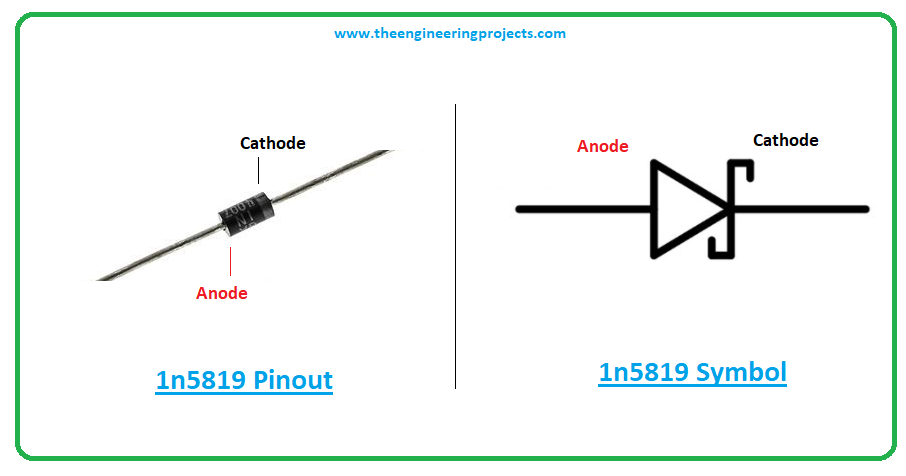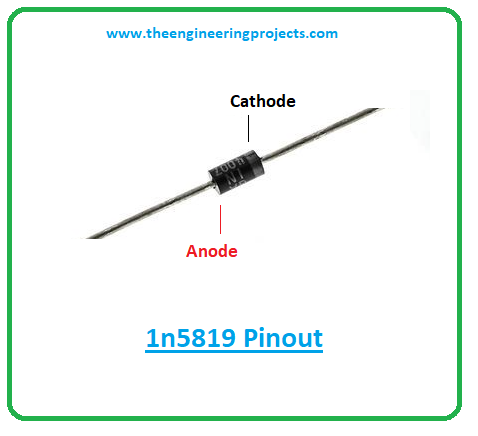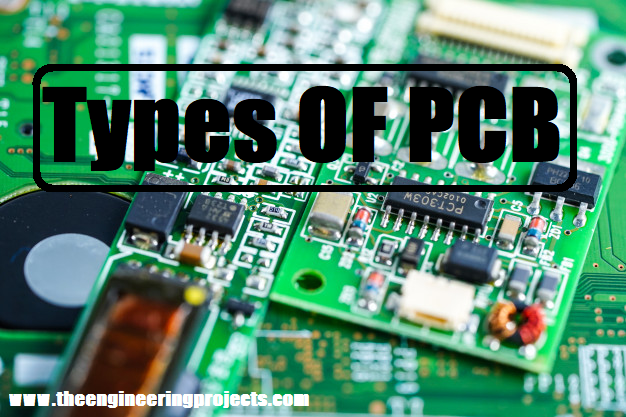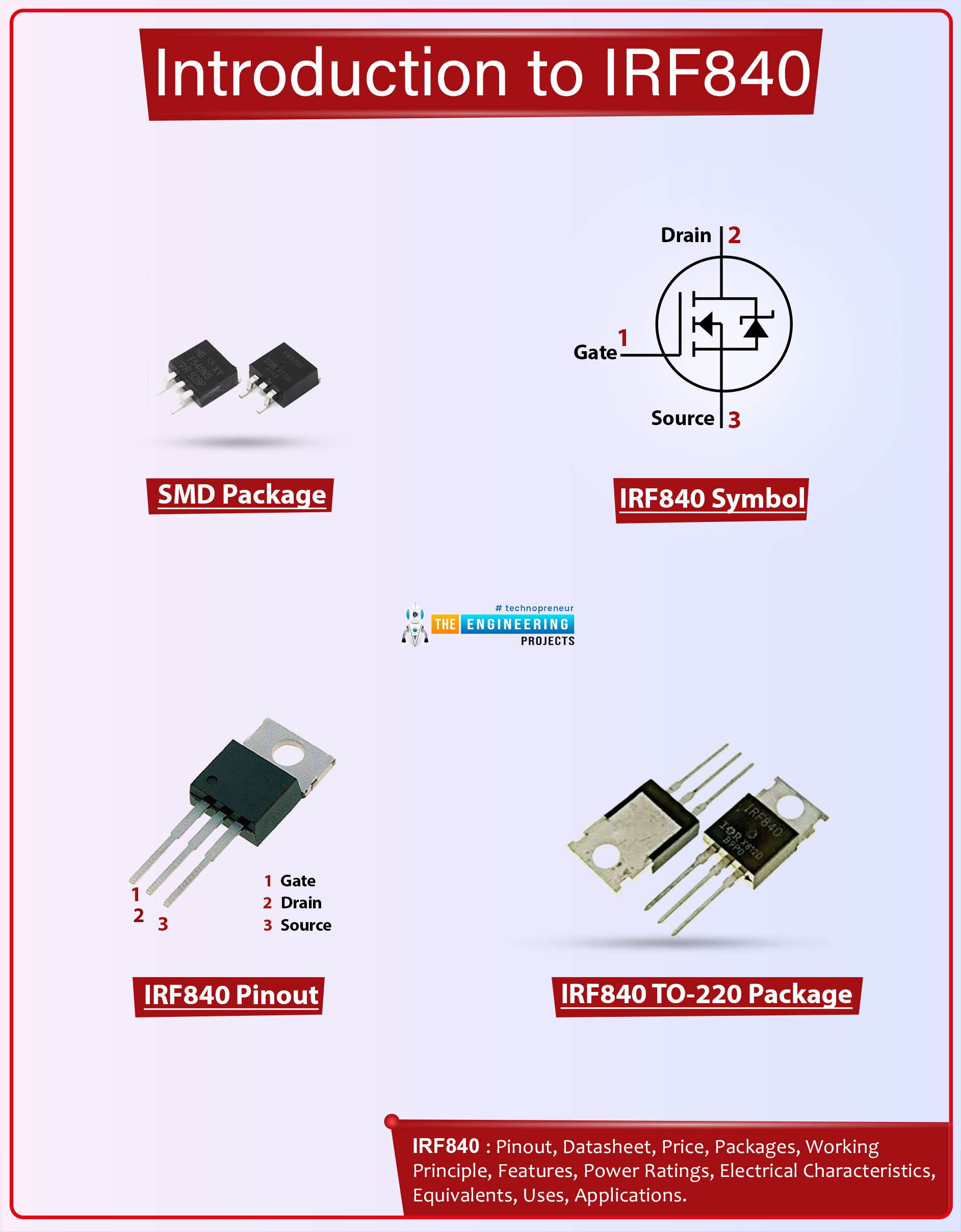

1N5819 Schottky Diode Datasheet, Pinout, Features & Applications


Introduction to 1N5819
- The 1n5819 is a Schottky diode used for fast switching applications.
- With high switching speed and low forward drop voltage, this device is employed in high-frequency applications like DC-DC inverters.
- This diode features low electronic energy in an unbiased condition that is responsible for the creation of a barrier inside the diode that in return blocks the movement of electrons. The formation of a barrier is the reason these Schottky diode devices are also known as a hot-carrier diode.

- The regular diodes and Schottky diodes are similar devices in terms of the current flow. Both favor the movement of current in one direction only i.e. from the anode terminal to the cathode terminal.
- These devices are different in terms of the voltage required to power up these devices. Output 2V DC voltage source applied to the diodes, Schottky diodes require only 0.3V, leaving behind 1.7V to power up the diode while regular diode requires only 0.7V leaving behind 1.3V to power up the regular diode.
1N5819 Datasheet
Before working with this component, it’s wise to go through the datasheet of the component that features the main characteristics of the device. You can download the datasheet of this device by clicking the link below.1N5819 Pinout
The picture below shows the pinout diagram of 1n5819.
- The component 1n5819 is composed of two terminals. These terminals are used for the external connection with the electrical circuit.
- One terminal is called anode that is positive while the other terminal is called cathode that is negative.
- The positive anode is made of metal material while the negative cathode is composed of semiconductor material.
- The conduction process is carried out from the anode terminal to the cathode terminal. An anode is an area from where current enters the diode and a cathode is the side from where it leaves the diode.
1N5819 Features
The following are the main features of 1n5819 that help you understand how this device is different from its peers available in the market.- Diode type = Schottky diode
- Semiconductor used = n-type
- RMS Reverse Voltage = 28V
- Average forward current = 1A
- Forward Voltage Drop = 600mV at 1A
- Forward Surge Current = 25A
- Peak reverse voltage = 40V
- Available package = DO-41
1n5819 Schottky Diode Construction
- This Schottky diode is made of metal and semiconductor material. The anode side is composed of metal while the cathode side is made of semiconductor material.
- The n-type semiconductor is used for the construction of the Schottky diode. The n-type semiconductor is a material where electrons are the majority carriers while the holes are minority carriers. You can also use p-type semiconductor material for the making of this Schottky diode but n-type materials are preferred over p-type material since the latter carries low forward drop voltage.
- When metals like tungsten, molybdenum, chromium, and platinum are attached with the n-type semiconductor material they constitute Schottky diode.
- In the Schottky diode, the current moves from the anode terminal to the cathode terminal and this diode blocks the movement of current in the opposite direction.
- The forward drop voltage on the Schottky diode is mainly related to the nature of metal and the semiconductor material used for the formation of a barrier that restricts the movement of electrons.
1N5819 Applications
The 1n5819 is used in the following applications.- Used to control the electronic charge.
- Used in freewheeling and logic circuits.
- Used in sample-and-hold circuits.
- Used in polarity protection and DC/DC converters applications.
- Used for signal detection and extremely fast switching applications.
- Used in radio frequency applications and solar systems.
- Used in high-frequency and low voltage inverters.
×
![]()








 1 user
1 user






 Continue Wishlist
Continue Wishlist





 Getting Started Guide
Getting Started Guide
 Help Center
Help Center
 Contact us
Contact us
 Doist Blog
Doist Blog
 Privacy
Privacy
 Security
Security
 Terms of Service
Terms of Service
 What's new: Channel Descriptions
What's new: Channel Descriptions





 Electronic Components
Electronic Components jameswilson
jameswilson 0 Comments
0 Comments








 2.3k
2.3k
 953
953
 921
921
 2.1K
2.1K
 Introduction to 1n5819
1n5819 pinout
1n5819 power ratings
1n5819 applications
Introduction to 1n5819
1n5819 pinout
1n5819 power ratings
1n5819 applications

 Friday, October 30, 2020
Friday, October 30, 2020
























